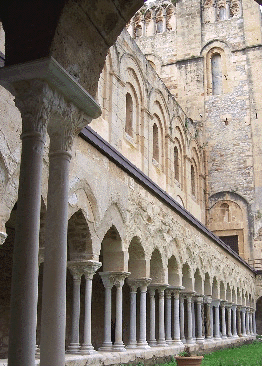...Best of Sicily presents... Best of Sicily Magazine. ... Dedicated to Sicilian art, culture, history, people, places and all things Sicilian. |
by Carlo Trabia | ||
Magazine Index Best of Sicily Arts & Culture Fashion Food & Wine History & Society About Us Travel Faqs Contact Map of Sicily |
Cefalù's cathedral is stylistically similar Saint Etienne in Normandy, featuring early Gothic accents in a solid Romanesque structure whose long, narrow nave externally is more aesthetic than Monreale's - especially when viewed from the rocky mountain next to it. The story of the church's foundation by Roger II following his shipwreck along Cefalù's coast during a storm in 1131 may well be imparted with legend, but the date is correct. Roger's father had sacked the town, then largely Arab, during the Normans' westward advance along the island's northern coast in 1063. then in 1131 the newly crowned King of Sicily appointed a Latin (Catholic) bishop to what had until then been a Byzantine (Orthodox) community. This was part of a serious attempt to bring the Latin brand of Christianity to Sicily's Byzantine northeast, and the establishment of Cefalù as a diocese brought the Benedictines to the region. With this effort most of Cefalù's Muslims converted to Catholicism by the end of the twelfth century, but a small Jewish community flourished until 1493 in a tiny quarter in the eastern part of town which can still be identified today.
King Roger loved Cefalù, and it was here that he wished to be buried - though his remains ended up in Palermo's cathedral. He had a small palace, now called the the Osteria Magna, in the town, where there was also a church dedicated to Saint George (shown), the patron of knights, long ago deconsecrated and converted to other use, in what is now Via Vittorio Emanuele, the street which runs along the shore. Both were constructed during the same period as the cathedral, but more rapidly. Owing to the time involved in erecting large Gothic cathedrals, the popular mind imagines these Romanesque ones to have taken generations to complete. In fact, they were completed within twenty years by large, competent work crews and dozens of highly skilled artisans. The style of Cefalù Cathedral is Norman-Byzantine with very few subtle Arab touches. It predates Monreale Abbey by several decades, and the mosaic of Christ Pantocrator in the apse (completed by 1148) rivals that of the newer church. There is little doubt that some of the same artisans - both Greek and French - worked on both churches, though some mosaics were added during the following century. The cathedral's bizarre windows are a recent addition. The cathedral is not quite "Romanesque Gothic," an Italian style that reached its fullness during the next century. The cloister itself is, with Monreale's, one of the two largest in Sicily. It is clear that the cloister, with its Provençal nuances, influenced the style and design of Monreale's. That but half of it survives is owed to wartime damage during the Summer of 1943. (Cefalù was abandoned by the retreating Germans and, less honorably, by the Italian troops whose duty it was to defend their home territory, but the Second World War in Sicily is an event that never could have been foreseen or even contemplated by even the most prescient thinkers of the Middle Ages.) The recently-completed restoration, like many such projects in Sicily, was undertaken over the course of twenty years - probably longer that it took the builders to complete the original construction eight centuries ago. The cloister is impressive for its size (comparable to Monreale's cloister in this regard), and many of the original capitals of the columns were decorated with figures from the Bible and popular legend. Shown here is Noah building his ark. Cefalù's cloister is open for two or three hours most mornings and then for an hour in late afternoon (presently from 3 to 4), and the price of admission is nominal. Entry is from the left side of the cathedral (as you face the facade) near the diocesan offices and bishop's residence. About the Author: Carlo Trabia is an architect who lectures on architectural history. | |
Top of Page |
 The recently-restored cloister garden
courtyard of
The recently-restored cloister garden
courtyard of  Cefalù is
Cefalù is